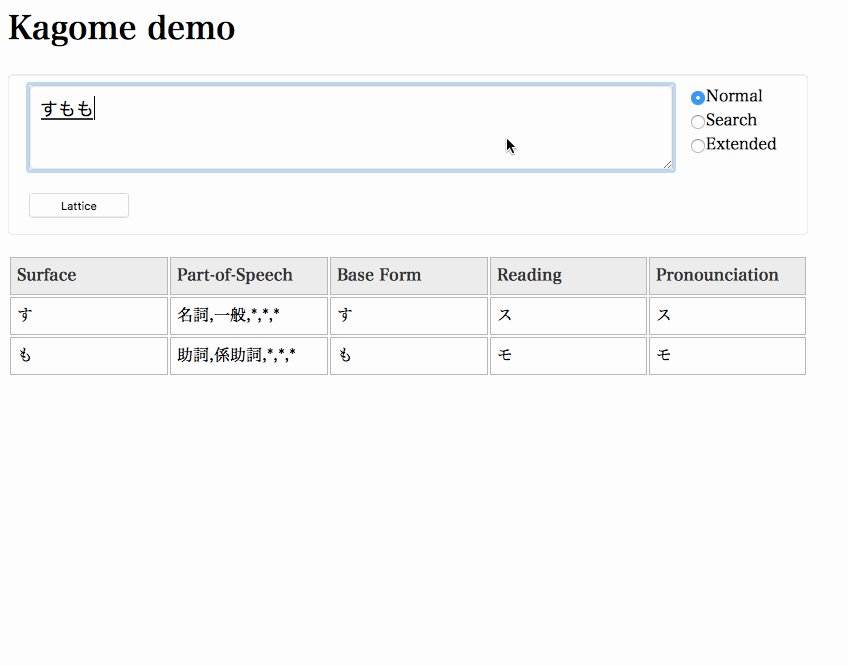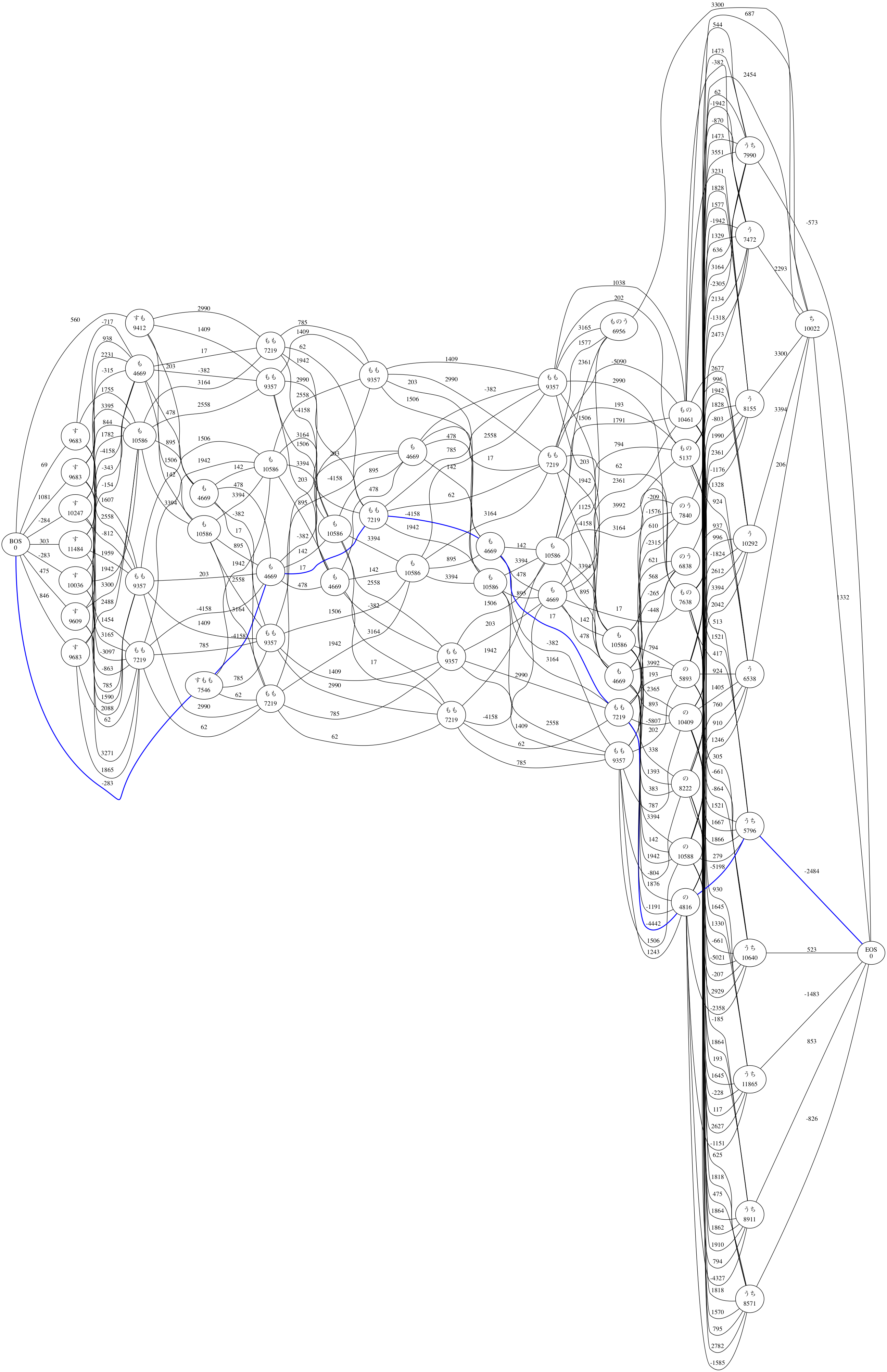



Kagome Japanese Morphological Analyzer
Kagome is an open source Japanese morphological analyzer written in pure golang.
The MeCab-IPADIC and UniDic (unidic-mecab) dictionary/statiscal models are packaged in Kagome binary.
% kagome
すもももももももものうち
すもも 名詞,一般,*,*,*,*,すもも,スモモ,スモモ
も 助詞,係助詞,*,*,*,*,も,モ,モ
もも 名詞,一般,*,*,*,*,もも,モモ,モモ
も 助詞,係助詞,*,*,*,*,も,モ,モ
もも 名詞,一般,*,*,*,*,もも,モモ,モモ
の 助詞,連体化,*,*,*,*,の,ノ,ノ
うち 名詞,非自立,副詞可能,*,*,*,うち,ウチ,ウチ
EOS
Install
% go get -u github.com/ikawaha/kagome/...
Usage
$ kagome -h
Japanese Morphological Analyzer -- github.com/ikawaha/kagome
usage: kagome <command>
The commands are:
[tokenize] - command line tokenize (*default)
server - run tokenize server
lattice - lattice viewer
tokenize [-file input_file] [-dic dic_file] [-udic userdic_file] [-sysdic (ipa|uni)] [-mode (normal|search|extended)]
-dic string
dic
-file string
input file
-mode string
tokenize mode (normal|search|extended) (default "normal")
-sysdic string
system dic type (ipa|uni) (default "ipa")
-udic string
user dic
Command line mode
$ go run cmd/kagome/main.go -h
or
$ go run cmd/kagome/main.go tokenize -h
Usage of tokenize:
-dic string
dic
-file string
input file
-mode string
tokenize mode (normal|search|extended) (default "normal")
-sysdic string
system dic type (ipa|uni) (default "ipa")
-udic string
user dic
Server mode
$ go run cmd/kagome/main.go server -h
Usage of server:
-http string
HTTP service address (default ":6060")
-sysdic string
system dic type (ipa|uni) (default "ipa")
-udic string
user dictionary
Segmentation mode for search
Kagome has segmentation mode for search such as Kuromoji.
- Normal: Regular segmentation
- Search: Use a heuristic to do additional segmentation useful for search
- Extended: Similar to search mode, but also unigram unknown words
| Untokenized |
Normal |
Search |
Extended |
| 関西国際空港 |
関西国際空港 |
関西 国際 空港 |
関西 国際 空港 |
| 日本経済新聞 |
日本経済新聞 |
日本 経済 新聞 |
日本 経済 新聞 |
| シニアソフトウェアエンジニア |
シニアソフトウェアエンジニア |
シニア ソフトウェア エンジニア |
シニア ソフトウェア エンジニア |
| デジカメを買った |
デジカメ を 買っ た |
デジカメ を 買っ た |
デ ジ カ メ を 買っ た |
HTTP service
Web API
$ kagome server -http=":8080" &
$ curl -XPUT localhost:8080/a -d'{"sentence":"すもももももももものうち", "mode":"normal"}'|jq .
{
"status": true,
"tokens": [
{
"id": 36163,
"start": 0,
"end": 3,
"surface": "すもも",
"class": "KNOWN",
"features": [
"名詞",
"一般",
"*",
"*",
"*",
"*",
"すもも",
"スモモ",
"スモモ"
]
},
{
"id": 73244,
"start": 3,
"end": 4,
"surface": "も",
"class": "KNOWN",
"features": [
"助詞",
"係助詞",
"*",
"*",
"*",
"*",
"も",
"モ",
"モ"
]
},
{
"id": 74989,
"start": 4,
"end": 6,
"surface": "もも",
"class": "KNOWN",
"features": [
"名詞",
"一般",
"*",
"*",
"*",
"*",
"もも",
"モモ",
"モモ"
]
},
{
"id": 73244,
"start": 6,
"end": 7,
"surface": "も",
"class": "KNOWN",
"features": [
"助詞",
"係助詞",
"*",
"*",
"*",
"*",
"も",
"モ",
"モ"
]
},
{
"id": 74989,
"start": 7,
"end": 9,
"surface": "もも",
"class": "KNOWN",
"features": [
"名詞",
"一般",
"*",
"*",
"*",
"*",
"もも",
"モモ",
"モモ"
]
},
{
"id": 55829,
"start": 9,
"end": 10,
"surface": "の",
"class": "KNOWN",
"features": [
"助詞",
"連体化",
"*",
"*",
"*",
"*",
"の",
"ノ",
"ノ"
]
},
{
"id": 8024,
"start": 10,
"end": 12,
"surface": "うち",
"class": "KNOWN",
"features": [
"名詞",
"非自立",
"副詞可能",
"*",
"*",
"*",
"うち",
"ウチ",
"ウチ"
]
}
]
}
Parameters
| Parameter |
Type |
Required |
Description |
| sentence |
string |
Required |
Sentenct to tokenize. |
| mode |
string |
Optional |
Mode to tokenize the sentence. Default is the "normal". Selectable value is "normal", "search" or "extended". |
Launch a server and access http://localhost:8888.
(To draw a lattice, demo application uses graphviz . You need graphviz installed.)
$ kagome -http=":8888" &


User Dictionary
User dictionary format is same as Kuromoji. There is a sample in _sample dir.
% kagome tokenize -udic _sample/userdic.txt
第68代横綱朝青龍
第 接頭詞,数接続,*,*,*,*,第,ダイ,ダイ
68 名詞,数,*,*,*,*,*
代 名詞,接尾,助数詞,*,*,*,代,ダイ,ダイ
横綱 名詞,一般,*,*,*,*,横綱,ヨコヅナ,ヨコズナ
朝青龍 カスタム人名,朝青龍,アサショウリュウ
EOS
Utility
A debug tool of tokenize process outputs a lattice in graphviz dot format.
$ kagome lattice -v すもももももももものうち |dot -Tpng -o lattice.png
すもも 名詞,一般,*,*,*,*,すもも,スモモ,スモモ
も 助詞,係助詞,*,*,*,*,も,モ,モ
もも 名詞,一般,*,*,*,*,もも,モモ,モモ
も 助詞,係助詞,*,*,*,*,も,モ,モ
もも 名詞,一般,*,*,*,*,もも,モモ,モモ
の 助詞,連体化,*,*,*,*,の,ノ,ノ
うち 名詞,非自立,副詞可能,*,*,*,うち,ウチ,ウチ
EOS

Programming example
Below is a simple go example that demonstrates how a simple text can be segmented.
sample code:
package main
import (
"fmt"
"strings"
"github.com/ikawaha/kagome/tokenizer"
)
func main() {
t := tokenizer.New()
tokens := t.Tokenize("寿司が食べたい。") // t.Analyze("寿司が食べたい。", tokenizer.Normal)
for _, token := range tokens {
if token.Class == tokenizer.DUMMY {
// BOS: Begin Of Sentence, EOS: End Of Sentence.
fmt.Printf("%s\n", token.Surface)
continue
}
features := strings.Join(token.Features(), ",")
fmt.Printf("%s\t%v\n", token.Surface, features)
}
}
output:
BOS
寿司 名詞,一般,*,*,*,*,寿司,スシ,スシ
が 助詞,格助詞,一般,*,*,*,が,ガ,ガ
食べ 動詞,自立,*,*,一段,連用形,食べる,タベ,タベ
たい 助動詞,*,*,*,特殊・タイ,基本形,たい,タイ,タイ
。 記号,句点,*,*,*,*,。,。,。
EOS
License
Kagome is licensed under the Apache License v2.0 and uses the MeCab-IPADIC, UniDic dictionary/statistical model. See NOTICE.txt for license details.
 Directories
¶
Directories
¶


